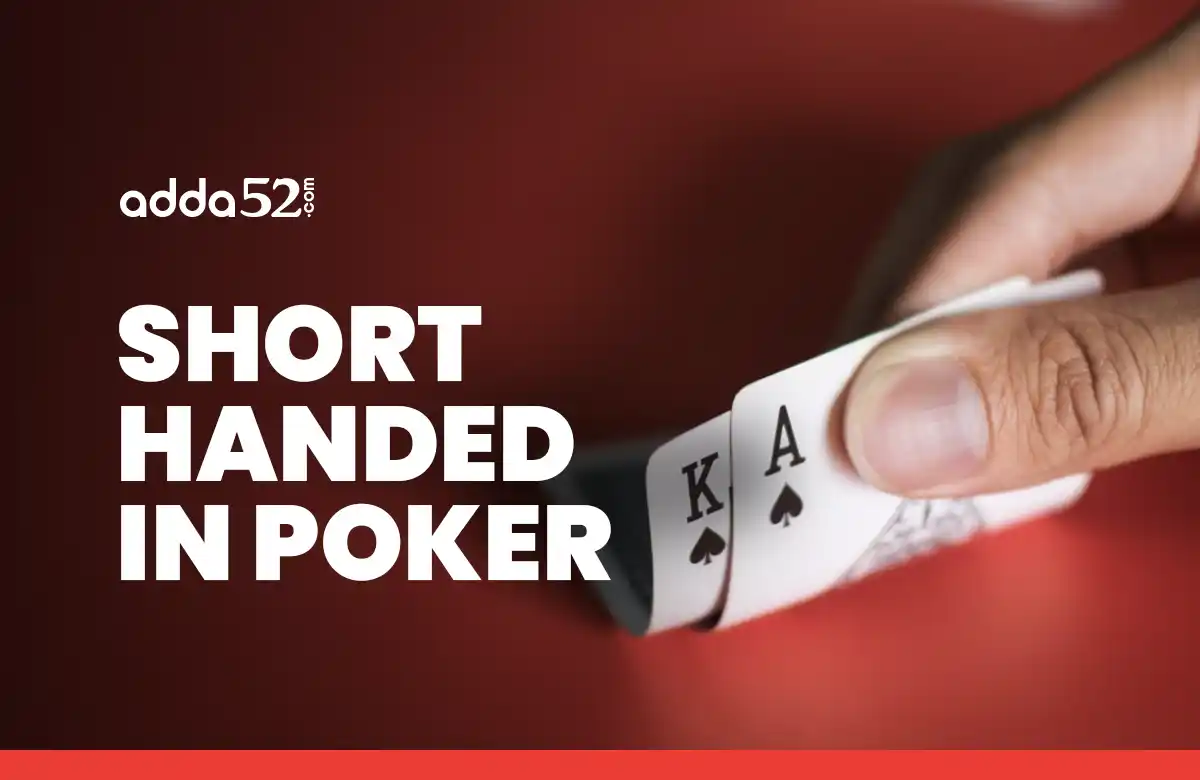
Introduction
Short-handed Poker’s quick and intense action has made it a favourite among players worldwide. Unlike full-ring Poker (9-10 players), it calls for a looser playing style, increased aggression, and sharper hand-reading abilities.
This guide will explore the key strategies to help you dominate short-handed tables like a pro.
Understanding Short-Handed Poker
Short-handed Poker refers to a game with six or fewer players at the table. The most common type is 6-max, but some games are played with 5-max, 4-max, or heads-up (2 players).
A full-ring game has 9 or 10 players, meaning players can afford to be selective with their starting hands. However, in short-handed poker, there are fewer opponents, meaning:
- Blinds come around faster.
- You must play more hands.
- Aggression is key to success.
Short-handed poker is common in:
- Cash games (where players buy-in for real money)
- Tournaments (where tables reduce in size as players get eliminated)
- Sit & Go’s (small, fixed-field tournaments)
Differences Between Short-Handed & Full-Ring Poker
|
Factor |
Full-Ring (9-10 Players) |
Short-Handed (6 or Fewer Players) |
|---|---|---|
|
Number of Players |
9-10 |
6 or fewer |
|
Starting Hand Selection |
Tight, premium hands preferred |
Loose, wider range |
|
Aggression Level |
Moderate |
High |
|
Blinds Pressure |
Slower rotation |
Blinds come around faster |
|
Multiway Pots |
Common |
Less Frequent |
|
Bluffing Frequency |
Moderate |
Higher |
|
Variance |
Lower |
Higher |
Short-Handed Poker Strategy
Winning in short-handed Poker requires a fundamentally different approach than full-ring Poker.
Preflop Strategy
In full-ring games, folding marginal hands and waiting for strong holdings is okay. In short-handed poker, waiting for premium hands like AA, KK, or AK will cause you to lose money due to the increasing number of blinds and antes.
Hand Selection in Short-Handed Poker
Here’s a general guideline for what hands to open with from different positions in a 6-max cash game:
|
Position |
Opening Range |
|---|---|
|
Under the Gun (UTG - First to Act) |
22+, A9s+, KTs+, QTs+, JTs, AJo+, KQo |
|
Middle Position (MP) |
22+, A7s+, K9s+, QTs+, J9s+, ATo+, KJo+
|
|
Cutoff (CO) |
22+, A5s+, K7s+, Q9s+, J9s+, A9o+, KTo+ |
|
Button (BTN) |
22+, A2s+, K5s+, Q8s+, J8s+, T8s+, 98s, A7o+, K9o+, QTo+, JTo |
|
Small Blind (SB) |
22+, A2s+, K5s+, Q8s+, J8s+, T8s+, 98s, A7o+, K9o+, QTo+, JTo
|
- Steal More Blinds: Since blinds rotate faster, you must steal more aggressively, especially from the cutoff and button.
- 3-Bet Light More Often: Many players open wide, so increasing your 3-betting frequency forces them to fold weak hands.
- Defend Your Blinds More Aggressively: Since others will steal more, you must call or re-raise more often in the small blind and big blind.
Postflop Strategy
- Continuation Betting (C-Betting): Since most hands miss the flop, continuation betting frequently (especially in position) can take down many pots.
- Adjust based on board texture: On dry boards (e.g., K♠-7♣-2♦), you should c-bet frequently. On wet boards (e.g., J♥-10♥-8♠), it is recommended to c-bet selectively.
- Bluffing & Semi-Bluffing More: Well-timed bluffs are more effective since opponents play wider ranges. Semi-bluffing with draws (flush draws, straight draws) gives you equity when called.
- Value Betting More Thinly: Hands like top pair good kickers (e.g., KQ on K-7-2) are often strong enough for multiple streets of value. Don’t slow-play too often, as aggressive opponents will bet themselves.
How to Play Short-handed Games Against Different Opponents
Short-handed games are full of different player types. Recognizing and adjusting to these opponents is key.
|
Opponent Type |
How to Adjust |
|---|---|
|
Loose-Aggressive (LAG) |
3-bet more, trap with strong hands, call more with medium strength hands. |
|
Tight-Aggressive (TAG) |
Steal blinds more, float the flop, don’t get into big pots without a strong hand. |
|
Loose-Passive (Fish) |
Value bet relentlessly, bluff less, isolate them whenever possible. |
|
Tight-Passive (Nit) |
Steal blinds frequently, bluff more, fold when they show aggression. |
Common Mistakes in Short-Handed Poker
-
Playing Too Tight: In short-handed games, you have to play a broader range of hands, as waiting for monsters will cause you to get blinded out quickly. The position becomes even more critical, and hands like suited connectors, broadways, and small pocket pairs gain more value. Players who fail to open their ranges in late position miss out on opportunities to steal blinds and apply pressure on their opponents.
-
Overplaying Hands Like Top Pair: Many players assume that if they hit the top pair, they are automatically ahead, leading them to make aggressive raises without considering their opponent's range. However, in a fast-paced game, your opponents also play a wider range, which means two pairs, sets, and strong draws appear more frequently. Instead of blindly stacking off, players should assess bet sizing and possible hand combinations that could beat their opponents.
-
Calling Too Much Instead of Betting or Raising: Many players fall into the trap of calling too often, hoping to see a cheap showdown. This approach allows aggressive opponents to dictate the pace of the hand, leaving passive players constantly guessing. Instead of flat-calling in situations where you believe you have the best hand, it's often better to bet or raise to extract value and take control of the pot.
-
Letting Emotions Take Over (Tilt Issues): Many players let frustration or bad beats affect their decision-making, leading to tilt-induced mistakes. Going on tilt often results in reckless aggression, poor calls, and desperate plays. Maintaining emotional control is crucial, as poker is a long-term game. Taking breaks, reviewing hands objectively, and focusing on making the best possible decisions rather than being results-oriented can help avoid tilt.
Bankroll Management for Short-Handed Poker
The ideal bankroll requirements depend on whether you are playing cash games, sit-and-go’s (SNGs), or multi-table tournaments (MTTs).
Cash Games
For short-handed cash games, a conservative bankroll requirement is:
- 30-50 buy-ins for regular players
- 50-100 buy-ins for high-variance styles (LAG or very aggressive players)
For example, if you are playing ₹10/₹20 No-Limit Hold’em (NL20) with a 100BB buy-in of ₹2,000, you should have at least ₹60,000 to ₹1,00,000 in your bankroll to handle variance. If you prefer an aggressive bankroll strategy, you might play with as few as 20 buy-ins, which increases your risk of breaking.
Sit and Go (SNG) Tournaments
Single-table SNGs have moderate variance, but the swings are more severe in short-handed formats like 6-max or heads-up SNGs. The recommended bankroll is:
- 50-100 buy-ins for regular SNG players
- 100-200 buy-ins for hyper-turbos or aggressive bankroll approaches
For instance, if you play ₹500 buy-in SNGs, you should have at least ₹50,000 to ₹1,00,000 in your bankroll to manage variance.
Multi-Table Tournaments (MTTs)
MTTs have the highest variance of all Poker formats. Even strong players can go through extended downswings due to the top-heavy payout structures. For short-handed MTTs, the suggested bankroll is:
- 100-200 buy-ins for regular tournaments
- 200-500 buy-ins for high-field or turbo events
If you are playing ₹1,000 buy-in short-handed MTTs, you should have a bankroll of at least ₹1,00,000 to ₹2,00,000, with more required for higher-variance structures.
Bankroll Strategy for Short-handed Poker
-
Move Down in Stakes When Necessary: If your bankroll drops below the recommended number of buy-ins, dropping to a lower limit helps protect you from going broke. For example, if you start with a ₹1,00,000 bankroll playing ₹10/₹20 cash games but fall to ₹40,000, moving down to ₹5/₹10 games is a smart decision.
-
Avoid Chasing Losses: Losing streaks can be frustrating, but increasing stakes to ‘win back’ losses is one of the biggest bankroll mistakes. This leads to playing at levels where you are financially uncomfortable, often resulting in poor decisions. Instead of chasing losses, focus on improving your game and playing at a level where you are properly bankrolled.
Frequently Asked Questions
What is short-handed in Poker?
Short-handed refers to games with six or fewer players at the table, commonly found in 6-max cash games and final table tournament play. The game is more aggressive than full-ring poker, requiring wider hand ranges, increased bluffing, and stronger post-flop play to succeed.
How to adjust your starting hand range in short-handed Poker?
In short-handed Poker, you must play more hands than in full-ring games. Hands like A♠-T♠, K♣-J♣, or 8♦-7♦ become stronger, and you should raise more often, especially from late positions. Avoid being too passive, as aggression wins in short-handed Poker.
How to adjust post-flop play in short-handed games?
Short-handed Poker has more one-on-one post-flop battles. Use continuation bets (c-bets) frequently, play strong draws aggressively, and watch opponents' betting patterns to exploit their weaknesses.
Conclusion
Short-handed Poker is a game of smart aggression. With fewer players at the table, every decision carries more weight, making it essential to widen your range. Unlike full-ring Poker, passivity won’t get you far in short-handed Poker. You need to take control of the pots and dictate the action.
